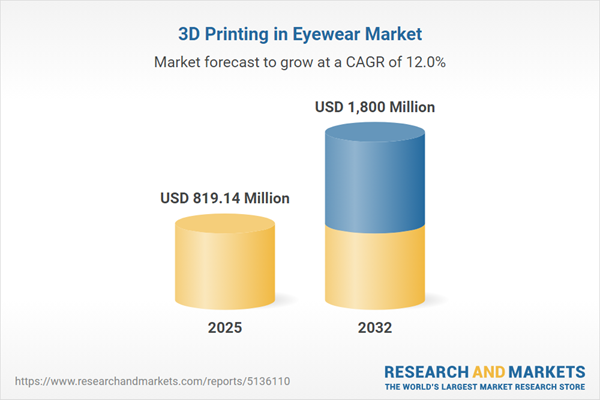Speak directly to the analyst to clarify any post sales queries you may have.
Senior executives in the eyewear industry are encountering a transformation in manufacturing and consumer engagement as 3D printing becomes integral to product design and market adaptation. This shift offers both operational opportunities and competitive challenges, demanding forward-thinking strategies for sustained business advantage.
Market Snapshot: 3D Printing in Eyewear Market Overview
Between 2024 and 2032, the global 3D printing in eyewear market is projected to expand from USD 729.56 million to USD 1.80 billion, reflecting a compound annual growth rate (CAGR) of 12.01%. This robust increase is driven by the accelerated integration of additive manufacturing, streamlining production cycles and allowing companies to better align products with shifting consumer preferences. At the executive level, digital initiatives are increasingly shaping process flexibility, supporting rapid updates to design portfolios and stock management. Emphasizing compliance and transparency is becoming essential for organizations to remain competitive while maintaining operational risk management and adhering to evolving industry standards.
Scope & Segmentation of the 3D Printing in Eyewear Market
- Product Types: Eyewear frames, lenses, hinges, and nose pads are segmented for precise market assessment. High customization and fully 3D-printed parts drive comfort and design adaptability, helping brands address diverse end-user requirements and niche preferences.
- Technologies: Leading players employ Digital Light Processing, Fused Deposition Modeling, Selective Laser Sintering, and Stereolithography. These additive methods support rapid prototyping, enable low-volume series manufacturing, and unlock innovative shapes and functionalities not achievable through conventional means.
- Materials: Choices range from composites and advanced plastics to metals and photopolymer resins. Selection is guided by durability requirements, mechanical standards, and the need for differentiated styles in both high-performance and aesthetic applications.
- Applications: Additive techniques enhance prescription eyewear, sports glasses, sunglasses, and safety models. Each category gains from improved fit, functional enhancements, and tailored product development, benefitting both specialty and mass-market segments.
- Distribution Channels: Market access includes retail, wholesale, and direct-to-consumer. The adoption of online configurators, virtual try-on experiences, and automated fulfillment tools is improving purchasing journeys and enabling responsive customer engagement.
- Regions & Selected Countries: Coverage spans the Americas, Europe, Middle East & Africa, and Asia-Pacific. Nations such as the United States, Germany, China, and Australia lead technology adoption and influence regulatory and logistical strategy for companies serving international clients.
- Key Companies Profiled: Major firms include Materialise NV, Sculpteo SAS, Monoqool ApS, MYKITA GmbH, Carbon Inc., HOYA Corporation, EssilorLuxottica S.A., Carl Zeiss Meditec AG, Luxexcel Technologies BV, and You Mawo GmbH, all actively shaping production standards and supply reliability through digital manufacturing leadership.
Key Takeaways for Senior Decision-Makers
- Implementing 3D printing ensures eyewear manufacturers can quickly adapt portfolios to dynamic consumer and market trends while improving operational workflows.
- Strategic collaborations among manufacturers, technology specialists, and designers accelerate product launches and broaden distribution, facilitating quicker responses to market shifts.
- Aligning digital production with real-time demand data heightens agility, reduces surplus stock, and supports a nimble supply chain in a volatile market environment.
- Material and process choices should be tailored to meet regulatory compliance and performance standards, especially in segments with strict oversight.
- Prioritizing automation and resilient supply models is key to meeting both organizational sustainability goals and increasing consumer demand for corporate responsibility.
- Proactive training programs and technology upgrades can mitigate operational risks associated with market and supply chain volatility.
Tariff Impact: Navigating Cost and Supply Chain Adjustments
Changing tariff structures on imported 3D-printed eyewear components prompt companies to evaluate and strengthen supply chain continuity. Moving toward local production, investing in cutting-edge processes, and upskilling staff enhance flexibility and operational consistency. Although these measures may result in up-front costs, they support organizational resilience and help manage fluctuations in regulatory requirements and market unpredictability.
Methodology & Data Sources
This research draws from peer-reviewed sources, compliance and regulatory materials, and interviews with industry leaders. Data are validated through triangulated cross-verification and external review, providing senior leaders with strategic and reliable insights for informed decisions.
3D Printing in Eyewear Market: Why This Report Matters
- Equips leadership teams to optimize digital manufacturing adoption, align with global compliance standards, and capitalize on emerging opportunities.
- Supports executive decision-making with resource allocation, industry partnership strategies, and planning grounded in actionable intelligence and market signals.
- Strengthens organizational capability to handle regulatory and supply chain complexities, fostering long-term operational reliability.
Conclusion
Sustained market positioning in 3D-printed eyewear relies on regulatory alignment, operational efficiency, and strategic use of digital manufacturing. Executives who drive these priorities can future-proof organizations and navigate evolving industry challenges.
Additional Product Information:
- Purchase of this report includes 1 year online access with quarterly updates.
- This report can be updated on request. Please contact our Customer Experience team using the Ask a Question widget on our website.
Table of Contents
3. Executive Summary
4. Market Overview
7. Cumulative Impact of Artificial Intelligence 2025
Companies Mentioned
The companies profiled in this 3D Printing in Eyewear market report include:- Materialise NV
- Sculpteo SAS
- Monoqool ApS
- MYKITA GmbH
- Carbon, Inc.
- HOYA Corporation
- EssilorLuxottica S.A.
- Carl Zeiss Meditec AG
- Luxexcel Technologies BV
- You Mawo GmbH
Table Information
| Report Attribute | Details |
|---|---|
| No. of Pages | 188 |
| Published | October 2025 |
| Forecast Period | 2025 - 2032 |
| Estimated Market Value ( USD | $ 819.14 Million |
| Forecasted Market Value ( USD | $ 1800 Million |
| Compound Annual Growth Rate | 12.0% |
| Regions Covered | Global |
| No. of Companies Mentioned | 11 |









